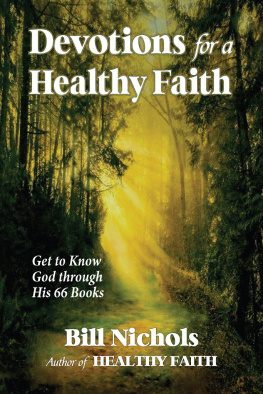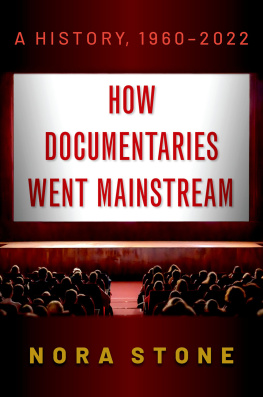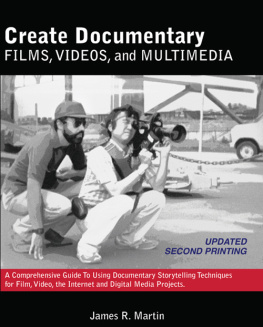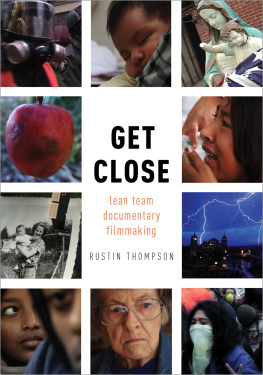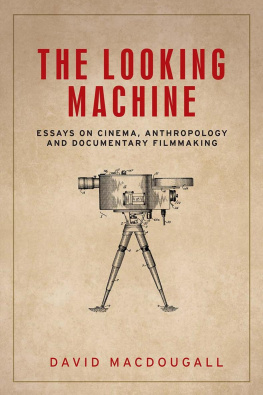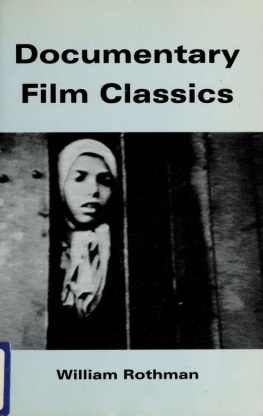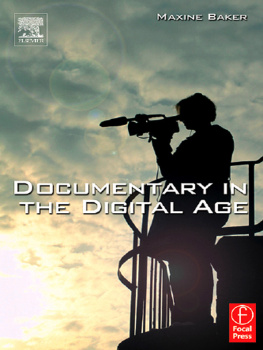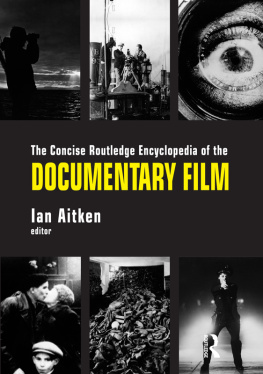INTRODUCTION TO DOCUMENTARY
INTRODUCTION TO DOCUMENTARY
Third Edition
Bill Nichols

This book is a publication of
Indiana University Press
Office of Scholarly Publishing
Herman B Wells Library 350
1320 East 10th Street
Bloomington, Indiana 47405 USA
iupress.indiana.edu
2017 by Bill Nichols
All rights reserved
No part of this book may be reproduced or utilized in any form or by any means, electronic or mechanical, including photocopying and recording, or by any information storage and retrieval system, without permission in writing from the publisher. The Association of American University Presses Resolution on Permissions constitutes the only exception to this prohibition.
The paper used in this publication meets the minimum requirements of the American National Standard for Information SciencesPermanence of Paper for Printed Library Materials, ANSI Z39.48-1992.
Manufactured in the United States of America
Library of Congress Cataloging-in-Publication Data
Names: Nichols, Bill, 1942- author.
Title: Introduction to documentary / Bill Nichols.
Description: Third edition. | Bloomington : Indiana University Press, 2017. | Includes bibliographical references and index.
Identifiers: LCCN 2016045756 (print) | LCCN 2016057720 (ebook) | ISBN 9780253026347 (cloth : alk. paper) | ISBN 9780253026859 (pbk. : alk. paper) | ISBN 9780253026903 (e-book)
Subjects: LCSH: Documentary films--History and criticism.
Classification: LCC PN1995.9.D6 N539 2017 (print) | LCC PN1995.9.D6 (ebook) | DDC 070.1/8dc23
LC record available at https://lccn.loc.gov/2016045756
1 2 3 4 5 22 21 20 19 18 17
To all the students, filmmakers, and colleagues
who have taught me over the years.
CONTENTS
ACKNOWLEDGMENTS
My greatest debt of gratitude goes to the students who have studied documentary film with me over the years. Their curiosity and questions have provided the motivation for this book. I am also greatly indebted to those who have gathered at the Visible Evidence conferences since their inception in 1993 to exchange ideas and pursue debates about documentary film. These conferences, initiated by Jane Gaines and Michael Renov, have proven invaluable to the promotion of a lively dialogue about documentary film in the broadest possible terms.
Without the assistance of the filmmakers who so generously provided still images of their work, this book would be greatly impoverished. I thank them for their willingness to provide superb illustrations, often on short notice.
Michael Wilson, Victoria Gamburg, Tori Palmatier, David Gray, and Jed Miner provided invaluable help on various editions and myriad tasks.
INTRODUCTION
The third edition of Introduction to Documentary examines this fascinating type of filmmaking through a series of questions that involve issues of definition, ethics, content, form, modes, and politics. It adds a new chapter on how to make a documentary that focuses on preproduction, the first step to making a documentary. All other chapters have been revised and updated.
Because documentaries address the world in which we live rather than a world imagined by the filmmaker, they differ from the various genres of fiction (science fiction, horror, adventure, melodrama, and so on) in significant ways. They are made with different assumptions, they involve a different relationship between filmmaker and subject, and they prompt different sorts of expectations from audiences
These differences, as we shall see, guarantee no absolute separation between fiction and documentary. Some documentaries make strong use of practices such as scripting, staging, reenactment, rehearsal, and performance that we associate with fiction. Some adopt familiar conventions such as the individual hero who undergoes a challenge or embarks on a quest, building suspense, emotional crescendos, and climactic resolutions. Some fiction makes strong use of conventions that we typically associate with nonfiction or documentary such as location shooting, nonactors, handheld cameras, improvisation, found footage (footage not shot by the filmmaker), voice-over commentary, and natural lighting. The boundary between the two realms is highly fluid but, in most cases, still perceptible. Documentaries are, as I have argued elsewhere, a fiction (un)like any other.
Because notions about what is distinct to documentary, and what is not, change over time, specific films may well spark debate about the boundaries of fiction and nonfiction. At one point Eric von Stroheims Greed (1925) and Sergei Eisensteins Strike (1925) were praised for the high degree of realism or verisimilitude they brought to their stories. They possessed a documentary appeal. At another point Roberto Rossellinis Rome, Open City (1945) and John Cassavetess Shadows (1960) seemed to bring lived reality to the screen in ways not previously experienced. Although all these works have been normally treated as fiction, a case could be made for the power of their documentary dimensions and their ability to stimulate both documentary and fiction filmmakers to rethink their assumptions. Reality TV shows like American Idol, the multiple versions of The Real Housewives, Swamp People, and Survivor heighten the degree to which television can exploit a sense of documentary authenticity and melodramatic spectacle simultaneously. And films such as Forrest Gump (1994), The Truman Show (1998), The Blair Witch Project (1999), and The Road to Guantnamo (2006) build their narratives around the underlying premise of documentary: we feel a distinct fascination when we witness the lives of others who seem to belong to the same historical world that we do.
Film, video, and now digitally based images can bear witness to what took place in front of the camera with extraordinary fidelity. Painting and drawing seem a pale imitation of reality compared to the sharp, highly defined, precise representations available on film, video, or computer monitors. Yet this fidelity serves the needs of fiction filmmaking as much as it facilitates the work of medical imaging through the use of X-rays, MRIs, or CT scans. The fidelity of the image may be as crucial to a close-up of Leonardo DiCaprio or Cate Blanchett as it is to an X-ray of a lung, but the uses of that fidelity are vastly different. We may know that both offer evidence about the world around us, but we treat the former as evidence highly filtered through the eyes of the filmmaker and the latter as an almost direct, untampered transcription of specific properties found in the world. We believe what we see at our own risk.
As digital media make all too apparent, fidelity lies in the mind of the beholder as much as it lies in the relationship between a camera and what comes before it. (With digitally produced images, there may be no camera and nothing that ever came before it, even if the resulting image bears an extraordinary fidelity to familiar people, places, and things.) Whether what we see is exactly what we would have seen had we been present alongside the camera cannot be guaranteed.
Certain technologies and styles encourage us to believe in a tight, if not perfect, correspondence between image and reality, and the effect of lenses, focus, contrast, depth of field, color, and high-resolution media (such as fine-grain film or digital images with over 300 pixels per square inch) seem to guarantee the authenticity of what we see. They can all be used, however, to give the
Next page

